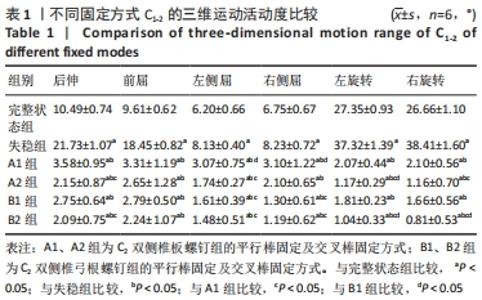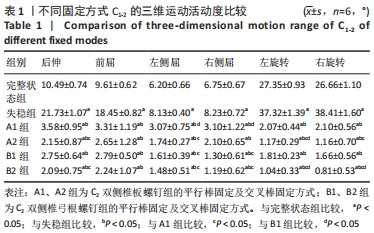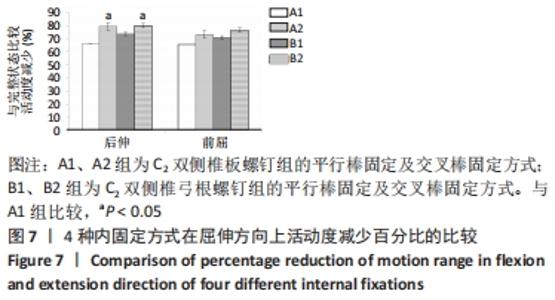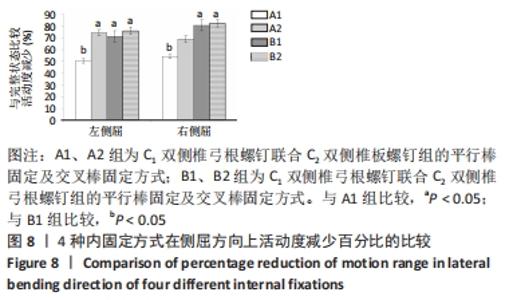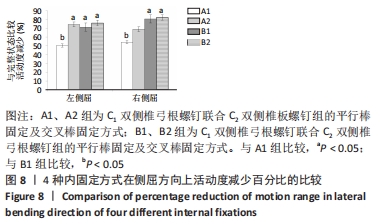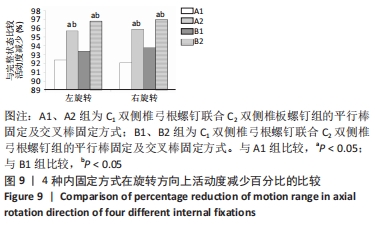[1] 陶春生,孙培锋,赵金柱,等.线缆内固定融合术治疗创伤性寰枢椎不稳的中远期疗效[J].脊柱外科杂志,2021,19(4):239-242.
[2] 屈巍,闫亮,宋宗让,等. 寰枢椎弓根螺钉置入单节段固定治疗Jefferson骨折合并不稳定齿状突骨折[J]. 中国组织工程研究,2017, 21(31):4957-4962.
[3] 王颖博,胡波,刘瑶瑶,等.后路寰枢固定融合术治疗齿状突畸形伴创伤后寰枢关节脱位的疗效观察[J].创伤外科杂志,2019,21(9): 663-666+682.
[4] 马维虎.寰枢椎后路钉棒固定融合技术的合理应用[J].中华医学杂志,2020,100(45):3562-3565.
[5] 陈凯,陈绪国,胡勇,等.3D打印导向模板辅助寰枢椎后路椎弓根螺钉固定治疗寰枢椎不稳症疗效分析[J]. 现代实用医学,2019,31(1): 70-72,封4.
[6] 王圣林,田英轮,许南方,等.颈椎后路“组合式”内固定治疗寰枢关节不稳或脱位的临床疗效[J].中国脊柱脊髓杂志,2020,30(4): 338-345.
[7] 马向阳,杨进城,邱锋,等. 枕颈交叉棒临床固定技术的建立与临床应用[J].中国骨与关节损伤杂志,2015,30(11):1121-1123.
[8] 邱锋,许喜林,马向阳,等.枕骨板联合C_2双侧椎板螺钉交叉棒固定稳定性的生物力学研究[J].中国修复重建外科杂志,2020, 34(12):1545-1549.
[9] 邱锋,许喜林,马向阳,等.C2椎板螺钉短节段钉棒固定系统中交叉棒与平行棒固定的生物力学比较[J].中国组织工程研究,2021, 25(12):1805-1809.
[10] CHEN J, ZHOU F, NI B, et al. New Posterior Atlantoaxial Restricted Non-Fusion Fixation for Atlantoaxial Instability: A Biomechanical Study. Neurosurgery. 2016;78(5):735-741.
[11] LIU S, SONG Z, LIU L, et al. Biomechanical evaluation of C1 lateral mass and C2 translaminar bicortical screws in atlantoaxial fixation: an in vitro human cadaveric study. Spine J. 2018;18(4):674-681.
[12] WILKE HJ, WENGER K, CLAES L. Testing criteria for spinal implants: recommendations for the standardization of in vitro stability testing of spinal implants. Eur Spine J. 1988;7(2):148-154.
[13] 王正雷,王海斌,刘建辉,等.采用椎弓根螺钉内固定治疗寰枢椎骨折脱位[J].中国矫形外科杂志,2020,28(10):933-935.
[14] 郑建章,吴宏,胡世平,等.寰枢椎椎弓根钉内固定术治疗寰枢椎不稳疗效分析[J].中国骨与关节损伤杂志,2020,35(3):252-254.
[15] CHUN DH, YOON DH, KIM KN, et al. Biomechanical Comparison of Four Different Atlantoaxial Posterior Fixation Constructs in Adults: A Finite Element Study. Spine (Phila Pa 1976). 2018;43(15):E891-E897.
[16] 李小峰,赵朵,李炜峰,等.后路椎弓根螺钉单节段内固定治疗寰椎骨折[J].脊柱外科杂志,2019,17(6):379-382.
[17] 卢奕霖,朱健,孙凯强,等.新型C_1侧块-C_2椎弓根螺钉置钉导向器的临床应用[J].脊柱外科杂志,2021,19(4):233-238.
[18] 赵文龙,王洋,孙姣,等.寰椎椎弓根螺钉与侧块螺钉有限元分析比较[J].中国矫形外科杂志,2021,29(6):526-530.
[19] 马向阳,尹庆水,刘景发,等.寰椎侧块螺钉与寰椎椎弓根螺钉的解剖与生物力学对比研究[J]. 中国骨与关节损伤杂志,2005,20(6): 361-363.
[20] 陈毅,王利民,赵亮.红外导航辅助下枢椎椎弓根拉力螺钉微创内固定治疗Hangman骨折的疗效观察[J].颈腰痛杂志,2020,41(6): 650-653.
[21] 李健,彭剑,胡伟文.侧块螺钉技术与椎弓根螺钉技术治疗寰枢椎失稳的临床研究[J].临床军医杂志,2015,43(7):704-706.
[22] 江伟,张仕涛,方园,等. 后路寰枢椎钉棒固定融合术治疗类风湿性寰枢椎脱位的临床效果[J]. 临床医学研究与实践,2021,6(17): 90-92.
[23] 马向阳,尹庆水,吴增晖,等.枢椎椎板螺钉与椎弓根螺钉抗拔出强度的比较[J]. 中国脊柱脊髓杂志,2007,17(2):137-139.
[24] PARK JS, CHO DC, SUNG JK. Feasibility of C2 translaminar screw as an alternative or salvage of C2 pedicle screws in atlantoaxial instability. J Spinal Disord Tech. 2012;25(5):254-258.
[25] 马向阳,尹庆水,吴增晖,等.寰枢椎后路四种钉棒固定技术的三维稳定性评价[J].中国脊柱脊髓杂志,2008,18(6):464-468.
[26] PARK J, SCHEER JK, LIM TJ, et al. Biomechanical analysis of Goel technique for C1-2 fusion. J Neurosurg Spine. 2011;14(5):639-646.
[27] DIMITRIEV AE,LEHMAN RA,HELGESON MD, et al. Acute and long-term stability of atlantoaxial fixation methods. Spine. 2009;34(4):365-370.
[28] LEHMAN RA JR, DMITRIEV AE, WILSON KW. Biomechanical analysis of the C2 intralaminar fixation technique using a cross-link and offset connector for an unstable atlantoaxial joint. Spine. 2012;12:151-156.
[29] GABRIEL JP, MUZUMDAR AM, KHALIL S, et al. A novel crossed rod configuration incorporating translaminar screws for occipitocervical internal fixation: an in vitro biomechanical study. Spine. 2011;11:30-35.
[30] SHEN K, DENG Z, YANG J, et al. Biomechanical study of novel unilateral C1 posterior arch screws and C2 laminar screws combined with an ipsilateral crossed C1-C2 pedicle screw-rod fixation for atlantoaxial instability. Arch Orthop Trauma Surg. 2017;137(10):1349-1355.
|
